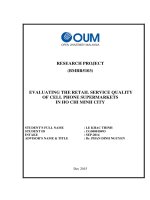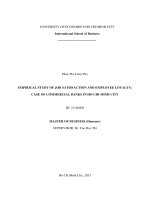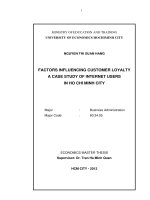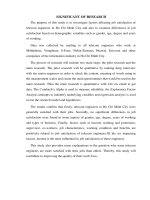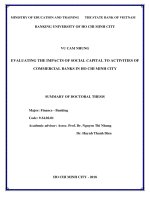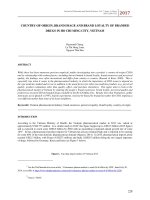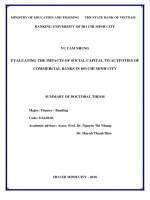Determinants of customer loyalty in retail banking in ho chi minh city
Bạn đang xem bản rút gọn của tài liệu. Xem và tải ngay bản đầy đủ của tài liệu tại đây (1.74 MB, 66 trang )
} ...~'(1!}>;1~·
i*llutu•• o1 Sodild ~·
. ~?...~.
.
·~:.
DETERMINANTS OF CUSTOMER LOYALTY
IN RETAIL BANKING IN HO CHI MINH CITY
BY
PHAM THI THU HA
MDE CLASS 15
... :·
'
. .._.,
··~
~·
"A thesis was submitted in partial fulfillment of the requirements for the
-·
Master of Development Economics degree (MDE) of Vietnam- Netherlands
program for M.A in Development Economics"
.,
'
'
July, 2011
~1
i
ACKNOWLEGEMENTS
I am greatly thankful to my supervisor, Dr Cao Hao Thi, whose valuable advice and guidance
at every stage of my thesis to help me to develop an understanding of this research.
I also give thanks to all professors, tutors, MDE staff for giving me academic knowledge and
advice and my classmates for encouragement to complete the thesis.
I would like to thank Service Managers at VCB and friends who works at banks who
supported me in building the questionnaires and collecting data for this study.
Finally, I would like to give special thanks to my parents, aunt and sister and friends who give
me great and warm support me to follow this MDE program.
In spite of my endeavour, this study may have many shortcomings and limitations. I am
looking forward to receive suggestions and opinions of teachers and colleagues.
I
-··
·.-
ABSTRACT
With the development of financial market in Vietnam especially retail banking sector, bank
managers should have many strategies to keep customers stay with their banks longer. The
bank mangers focus on the loyalty of their customers because they know the revenue and cost
savings from the old customers are greater than from the attracting the new ones. Thus, bank
managers need to find solutions to impact the factors that influence customer loyalty to
compete with the other banks. This study focuses on two objectives: identifying the
determinants of customer loyalty in retail banking in Ho Chi Minh city, and based on the
results to give recommendations to improve the loyalty of state-owned banks' customers, in
this case, it is Vietcombank. The qualitative and quantitative method will be applied to find
out the determinants of customer loyalty in retail banking. The findings of this research show
that factors which affect customer loyalty are Service Quality, Price and Switching Cost. They
have strong influence on customer loyalty with the strongest impact factor is Price (beta
coefficient 0.583) and two factors Service Quality (beta coefficient 0.327), Switching Cost
(0.301). Based on the findings, recommendations for Vietcombank to improve customer
loyalty such as: diversifying distribution channels and service-products, different price
strategies for each kind of customers, some special program for VIP customers, etc ... This
study only makes survey on 8 banks in HCMC, there are 2 state-owned banks (Vietcombank
and Agribank), 2 private-owned banks (ACB and VIBBank), 2 joint-venture banks (Indovina
Bank and Vid Public) and 2 foreign-owned banks (HSBC and Citibank). It should be widen to
more banks, big areas to increase the accuracy of the research. This study provides useful
information for future researchers who study customer loyalty in banking industry.
Keywords: Service quality, Price, switching cost, customer loyalty, retail banking.
11
TABLE OF CONTENTS
ACKNOWLEDGEMENTS ..................................................................................... i
ABSTRACT ............................................................................................................. ii
TABLE OF CONTENTS ........................................................................................ iii
LIST OF FIGURES ................................................................................................. vi
LIST OF TABLES ................................................................................................... vi
ABBREVIATIONS .................................................................................................. vii
CHAPTER I: INTRODUCTION ............................................................................ p. 1
1.1 Research Statement .............................................................................................. p. 1
1.2 Research Objectives ............................................................................................. p. 2
1.3 Research Questions .............................................................................................. p. 2
•
1.4 Research Scope ..................................................................................................... p. 2
1.5 Research Structure ................................................................................................ p. 2
CHAPTER II: LITERATURE REVIEW .............................................................. p. 4
2.1 Customer Loyalty ................................................................................................ p. 4
2.2 Factors affect Customer Loyalty .......................................................................... p. 5
2.2.1 Service Quality .................................................................................................. p. 5
2.2.2 Price ...................................................... ~ ............................................................ p. 7
2.2.3 Switching cost .................................................................................................. p. 8
2.3 Conceptual framework and hypotheses ................................................................ p. 9
2.4 Adjustment ofMeasurement Scales ..................................................................... p.lO
2.4.1 Service Quality .................................................................................................. p.l 0
2.4.2 Price ................................................................................................................... p.12
2.4.3 Switching cost .................................................................................................. p.12
lll
2.4.4 Customer Loyalty ............................................................................................. p.13
CHAPTER III: RESEARCH METHODOLOGY ................................................ p.15
3.1 Research Process ................................................................................................. p.15
3.2 Questionnaire Design ......................................................................................... p.16
3.3 Data Collection .................................................................................................... p.18
3.4 Data Analysis Technique ..................................................................................... p.18
3.4.1 Reliability .......................................................................................................... p.19
3.4.2 Validity ............................................................................................................. p.19
3.4 .3 Multiple Regression .......................................................................................... p.19
CHAPTER IV: DATA ANALYSIS AND FINGDINGS ...................................... p.20
4.1 Descriptive Statistics ........................................................................................... p.21
4.1.1 Sample size ....................................................................................................... p.21
4.1.2 Demographic Characteristics ............................................................................ p.22
4.2 Measurement Scale Refinement .......................................................................... p.23
4.2.1 Reliability Assessment ..................................................................................... p.23
4.2.2 Exploratory Factor Analysis ............................................................................. p.25
4.3 Hypotheses testing ............................................................................................... p.28
4.3 .1 Correlation Coefficient Analysis ...................................................................... p.29
4.3 .2 Multiple Regression Results ............................................................................. p.29
4.3 .3 Interpreting Customer Loyalty Equation and testing Hypotheses .................... p.31
4.3.4. Means Score Comparison between VCB with other banks and Industry
Average ..................................................................................................... p.31
4.3.4.1 Service Quality .............................................................................................. p.32
4.3 .4.2 Price ............................................................................................................... p.33
4.3.4.3 Switching cost ............................................................................................... p.33
iv
4.3.4.4 Customer Loyalty .......................................................................................... p.33
CHAPTER V: CONCLUSION AND RECOMMENDATIONS ......................... p.35
5.1 Summary offindings ........................................................................................... p.35
5.1.1 Determinants of Customer Loyalty .................................................................. p.35
5.1.2 Comparison between Vietcombank and Industry Average .............................. p.35
5.2 Recommendations to Vietcombank .......................................................... p.36
5 .2.1 Improving the Service Quality ......................................................................... p.36
5.2.2 Improving Price ................................................................................................ p.38
5.2.3 Improving Switching cost .................... ,............................................................ p.39
5.3 Limitations ........................................................................................................... p.39
5.4 Conclusion ........................................................................................................... p.39
References ................................................................................................................. p.41
APPENDICES
Appendix 1 Questionnaire- English version .............................................................. p.46
Appendix 2 Questionnaire- Vietnamese version ....................................................... p.49
Appendix 3: Reliability of all variables (23 items) ................................................... p.52
Appendix 4: Results of exploratory factor analysis
(EFA) .................................................................................................................. p.54
Appendix 5: Correlation of coefficients .................................................................... p.59
v
LIST OF FIGURES
Figure 2.1: Conceptual Framework of Customer Loyalty
Figure 3.1: Research process ..................................................................................... p.l5
Figure 4.1: Model of Customer Loyalty after carrying out EF A .............................. p.28
LIST OF TABLES
Table 2.1: Original Scales of Service Quality and research scales ............................ p.1 0
Table 2.2: Original Scales ofPrice and Research Scales .......................................... p.12
Table 2.3: Original Scales of switching cost and Research scales ............................. p.13
Table 2.4: Customer Loyalty ......................... :............................................................ p.13
Table 3.1: Variable Codes .......................................................................................... p.17
Table 4.1: Sample size ............................................................................................... p.20
Table 4.2: Demographic Characteristics ................................................................... p.22
Table 4.3: Reliability Test Results ............................................................................ p.23
Table 4.4: Results of Exploratory Factor Analysis .................................................... p.26
Table 4.5: Result of Customer Loyalty ..................................................................... p.27
Table 4.6: Correlation Matrix .................................................................................... p.29
Table 4.7: Model Summary ....................................................................................... p.29
Table 4.8: Coefficients .............................................................................................. p.29
Table 4.9: Model Summary ....................................................................................... p.30
Table 4.10: Coefficients ............................................................................................ p.30
Table 4.11: Means Score Comparison between VCB and other banks
and Industry Average ............................................................................. p.31
{
#
vi
ABBREVIATIONS
I SBV
State Bank of Vietnam
SMEs
Small and Medium Enterprises
WTO
World Trade Organization
SERVQUAL
Service Quality
EFA
Exploratory Factor Analysis
VCB
Vietcombank
ACB
Asia Commercial Bank
AGRI
Agribank
VIB
VIBBank
HSBC
Hongkong and Sanghai Bank Corporation
CITI
Citibank
INDO
Indovina Bank
VID
Vid Public Bank
SPSS
Statistical Package for Social Science
TAG
Tangibles
REL
Reliability
RES
Responsiveness
ASS
Assurance
EMP
Empathy
PR
Price
SQ
Service Quality
sw
Switching Cost
CL
Customer Loyalty
-·
vii
CHAPTER I: INTRODUCTION
l.lRESEARCH STATEMENT
From 1990 until now, number of banks increases highly especially private-owned banks and
foreign-owned bank branches, shows that attractive and potential development of Vietnam's
banking industry for domestic and foreign investors. According to the data of State Bank of
Vietnam (SBV) until October 2009, Vietnam's banking system has 3 state-owned banks, 40
private-owned banks, 5 joint-venture banks and 41 branches of foreign-owned bank. Vietnam
with population of 85 million people and increasing income is a potential market for
commercial banks. Moreover, many Government policies are issued to limit cash payment in
the public such as: pay salary through cards system, accepted banking documents in deducting
VAT, etc ...
Vietnam's accession to the World Trade Organization (WTO) with their commitments of
financial services market's liberalization and deregulation, their customers have more choice
between domestic and foreign banks. Furthermore, the customers access financial products
with no limitation, as a result, it affects to customer loyalty. In Vietnam, service market is
more and more improved and it is a new potential market for banks to explore. However, the
more increasing is personal income, the higher demands for products and services are.
Customers expect the higher quality of products and services than before. The higher
perceived service quality, the more satisfied and loyal the customers (Petruzzellis, D'Uggento
and Romanazzi, 2006). Beside the competing each other about the total assets and market
share (number of customers), efficiency in using the capital, ratio of bad debt, banks always
find out the customers' needs and supply at the right time to get the more market share. They
must try to offer attractive interest rates to both savers and borrowers, which means that they
must minimize their own internal operating costs and loss.
Nowadays, commercial banks have intend to develop retail sector, approach the individual
customers, small and medium enterprises (SMEs) because it is a large market and disperse
risks in banking business. Customers have opportunities to approach a lot of banks and choose
the best bank suitable to their own based on the price, service quality and convenience. In
2011, the competition is more and more heated when lots of commercial banks try to change
technology, reduce cost to strengthen competitive ability over the others. In this race, foreign-
owned banks have experience and strategy to expand their market in retail sector; privateowned and joint-venture commercial banks always change in technology, service quality and
staff skills, is it state-owned commercial banks known as 'to be hard to please' have
competitive ability with trials or not?
1.2 RESEARCH OBJECTIVES
The objectives of this study are:
•
To identify the key factors impact on customer's loyalty.
•
To measure the strength of relationship between key factors and loyalty.
•
Based on the research results to give recommendations to improve customer loyalty in
retail banking, especially Vietcombank- state-owned commercial bank.
1.3 RESEARCH QUESTIONS
In order to find out the solutions to improve customer loyalty of the retail banking, this study
deals with the following questions:
•
Which factors affect the customer loyalty?
•
How the banks improve and make their customers become loyal in retail sector?
•
What recommendations to Vietcombank about how to improve customer loyalty.
1.4 RESEARCH SCOPE
This study focuses on identifying the main factors influence on the customer loyalty in retail
banking in Viet Nam. The survey questionnaire is applied to collect data for this study with
the survey time from February to March, 2011. The survey interviewees of this study are
individuals who aged over 18 and usually go to the banks irrespective of purposes, gender,
age, income and education.
1.5 RESEARCH STRUCTURE
This study includes five sections compatible with five chapters with the names of theirs are:
introduction, literature review, research methodology, data analysis and findings, and
conclusions and recommendations. Chapter 1 introduces the structure of the research,
including research statement, research objectives, research questions and research scope.
Chapter 2- literature review consists of definitions of factors influencing on customer loyalty
as service quality, price and switching cost, and relevant literature review and evidence to
.-
2
clarify the research topic, the conceptual framework and hypotheses also are presented in this
chapter. The next chapter named research methodology that presents detail of qualitative and
quantitative research. Chapter 4 shows the results of sample size through the assessment of
measurement scale, this chapter also apply multiple regression analysis to test hypotheses.
The last chapter is chapter of conclusion and recommendations indicates the main findings of
the research and gives out some suggestions to improve customer loyal in retail banking,
finally, this chapter also shows the limitations of this research for further studies in the future.
3
-.
CHAPTER II: LITERATURE REVIEW
This chapter presents an overview of customer's loyalty and factors influencing on customer's
loyalty in retail banking. This chapter also presents conceptual framework, hypotheses of this
study and measurement scales of factors of customer loyalty and its affected factors.
2.1 CUSTOMER LOYALTY
Service loyalty can be defined in the following way: "Service loyalty refers the degree to
which a customer exhibits repeat purchasing behavior from a service provider, possesses a
positive attitudinal disposition toward the provider, and consider using only this provider
when a need for this service arises" (cited in Caruana, 2002, p813 ).
According to Oliver (1999), there are four stages of brand-loyalty such as: cognition, affect,
intentional and action loyalty. At the first stage-cognition, based on the information about the
brand that the customers collect, they are loyal to the brand. The next stage is affective loyal,
the customers have some positive attitudes toward a brand. When customers have behavioral
intention of purchasing, it is the intention phrase. The last stage is action loyalty when
customers change from intentions to actions.
Loyalty plays an important role in the competition of building successful relationships with
their customers in the competitive retail banking environment. According to Duncan and
Elliot (2002) showed that loyalty of customer takes an important part in contributing earnings
and profits of an organization. Nowadays, the financial institutions are in the process of
competition with globalization, a suitable customer loyalty program is necessary for them to
keep customers stay with their organizations. The banks always find many ways to supply the
most qualified services to satisfy the customers on the best way to get the maximum profit
and improve the comparative position over the trials. Some studies have pointed out that
profitability of banks is connected to customer retention (Garland, 2002; Anderson, Fornell
and Lehmann, 1994; Reichheld and Sasser, 1990). In real world, if one business increases 5%
loyal customers with satisfaction about his products and services, profit will increase from
25% to 85%. Customer loyalty provides the banks with great revenue and cost savings.
Surveys show that it is up to five times as expensive to recruit new customer as retain an
existing customer (Morgan, 2007; Clemens, Reichheld and Sasser, 1990). When most banks
4
provide nearly identical financial products and services, customers have attention to change
their behavior (Beckett, Hewer and Howcroft, 2000).
2.2 FACTORS AFFECT CUSTOMER LOYALTY
There are so many studies indicated factors influencing customer loyalty in many fields, in
banking field, the previous researches showed that customer loyalty is affected by factors
such as: service quality, price and switching cost.
2.2.1 Service Quality
Service quality is defined as an impression of customer about the overall and service
provision of an organization through the interactions between a customer and a service
provider (Bitner and Hubbert, 1994). There are many definitions of service quality, the widely
used one defines service quality as a measure of how well the service level provided meets
customer's expectations or needs (Lewis and Mitchell, 1990; Dotchin and Oakland, 1994a;
Asubonteng et al., 1996; Wisniewski and Donnelly. 1996). Spathis, Petridon and Glaveli
(2004) developed the perceived service quality as the customer's attitude to evaluate the
overall service provision. In the banking sector, Kamilia and Jacques (2000) stated that
perceived service quality is the difference between the customer expectations and the
perceived service provided by the bank.
Parasuraman et al (1988) clearly identified service quality into five dimensions through the
SERVQUAL model as follows:
•
Tangibles: Physical facilities, equipment and appearance of personnel.
•
Reliability: Ability to perform the promised service dependably and accurately.
•
Responsiveness: Willing to help customers and promote service.
•
Assurance: Knowledge and courtesy of employees and their ability to inspire trust and
confidence.
•
Empathy: Caring such as individualized attention which the employee provides for its
customers.
Tangibles relates to the effect of physical facility, equipment, personnel and communication
materials on customers; and reliability, responsiveness, assurance and empathy relate to
element of human intervention in the service delivery.
5
The five SERVQUAL dimensions ofParasuraman eta! (1985, 1988, 1991) have been applied
in evaluating service quality. For example, Levesque and McDougall (1996) based on the
SERVQUAL model to find the determinants of customer satisfaction in the bank. Avkiran
(1994) also based on the SERVQUAL measurement to identify four dimensions including 17
items in the Australian retail banking industry, there are: staff conduct, credibility,
communication and access to teller services. Ennew and Bink (1996) developed three banking
service quality dimension in United Kingdom, they are: knowledge, advice offered,
personalization in the service delivery and general product characteristics.
It is very difficult for customers to evaluate services at pre-consumption, consumption and
post-consumption stage. Because of intangible nature of services, it is also difficult for
organizations to understand how its customers perceive and evaluate the quality of its
services. Service quality is a comparative function between consumer expectations and actual
service performance (Parasuraman et a!., 1985). In the banking industry, there are two types
of perceived quality: (1) perceived quality product (tangible) is the assessment of customer
about the banks products and (2) perceived quality service (intangible) is the assessment
toward service related to products such as: service in and after purchasing, advanced and
delivery condition. Both perceived products and services are important attributes of perceived
quality of retail banking. Today's competition between organizations is comparing the
products and success of business is to have to deliver a diversified product to customers.
Easingwood and Storey (1995) showed that the important successful strategy is to introduce
new products successfully and service products related to technology can reduce transaction
costs, switching rate and encourage customers to create services outcomes on their own
(Bitner, Ostrom and Meuter, 2002). With intangible characteristics, perceived services of the
bank are lending condition, credit information, time to release a loan, manager and staff style,
transaction environment, etc.
With high service quality the firm will obtain a lot of advantages such as enhancing
reputation, increasing customer retention, attracting new customers through word-of-mouth,
creating competitive product difference and improving financing performance and
profitability (James 1998, Zeithaml et al., 1996; Julian and Ramaseshan, 1994). In the
banking sector, high service quality is always connected to customer loyalty. In an
investigation of Berggren and Dewar (1991) in United States found that 42% of customers
closed their accounts or switched to another bank as a result of service-related problem. In a
6
empirical evidence in Asian financial market (Islamic banks in Malaysia) of Dusuki and
Abdulla! (2006) showed that service quality of Islamic banks contributes to customer
satisfaction and influences customer's support for Islamic banking.
Service quality can affect customer's behavior, especially factors related to service quality
such as: speed of delivery, efficiency, friendliness, frequent communication can increase
customer's loyalty (Lewis and Soureli, 2006). Customer's behavior can be determined by
service quality: loyalty will be raised depend on perceived higher standards of service quality
than their expectations, on the other hand, poor service quality leads to the higher customer's
defection (Leed's, 1992; Zeithaml et al, 1996). In the investigation of Mavri and Loannou
(2008) of customer's switching behavior in Greek banking services, found that there is
positive relationship between good service quality and customer's loyalty.
2.2.2 Price
According to Zeithaml (1998), price is an attribute that must be given up or sacrificed to
obtain certain kinds of products or service. In a research of Keaveny (1995) stated that
'pricing' factor involves prices, rates, fees, charges, surcharges, service charges, penalties,
price deals, coupons, and price promotions.
Madill and colleagues (2002) showed that there are some advantages for customers and banks
in their relationships: the final goal of banks is to maximize profit, improve financial report
with low risk, the customers want to easily borrow money with suitable rate, etc .. Thus, the
good relationships with customers bring a lot of advantages to banks such as: reducing the
switching rate of customers and increasing the number of new customers through the
recommendations of their current customers. In the financial service industry, transaction cost
has wider implications than other service industries such as bank charges, interest rates
charged and paid, fee implementation (Gerrard and Cunningham, 2004).
Price is an important factor that can effect on customer satisfaction and behavioral intentions
(Varki and Colgate, 2001 ). Some studies of Stewart ( 1998), Colgate et al (1996) and Keaveny
(1995) also showed that price has strong influence on the customer's decision. Especially in
the banking sector, price has a wider implication, Gerrad and Cunningham (2004) found that
pricing seems to effect to customer loyalty of bank more than of other services. In the study of
Colgate and Hedge (2001) of customers' switching behavior determinants in Australia and
7
New Zealand, showed that price is the top switching determinant, followed by service failures
and denial of services.
Changing price can impact on customer's behavior (Varki and Colgate, 2001). In a survey of
Keaveney (1995) found that about 30% customers had switched firms because of poor service
price perceptions. Martins and Monroe (1994) showed that customers are sensitive to price,
any price increasing can lead to switching actions of customers (Campell, 1999). Gerrad and
Cunningham (2004) suggested that price plays an important role in the banking industry,
influencing customers' behavior compared with service failures and inconvenience. The
authors discussed that applying higher charges on customers or increasing fees can lead to
opposite effects such as switching behavior (leave the banks, stop to use the bank services,
etc). Moreover, Dawes (2004) showed that there is a positive relationship between prices
increases and defection rates in the banking industry. Therefore, transaction cost and
customer's loyalty are in negative relationship.
2.2.3 Switching Cost
Switching cost is cost of changing suppliers including financial and non-financial cost
(Matthews and Murray, 2007). Lee and Cunningham (200 1) showed that customer loyalty can
be affected not only by the cost of dealing with the service supplier but also by the cost of
switching to another supplier. There are many ways of categorizing switching cost. For
instance, Fornell (1992) divided switching costs into search costs, transaction costs, learning
cost, loyal customer discounts and emotional costs. Dick and Basu (1994) also summarized
switching costs into time costs, monetary costs and psychological costs. Matthews and
Murray (2007) summarized switching costs into three kinds: procedural switching costs which
including time and effort expenses related to evaluation costs, training and setup; financial
switching costs involving the loss of benefits and financial resources, and relational switching
costs associated with the loss of personal relationship and with the mark that can generate
emotional and psychological discomfort. In the banking industry, Matthews and Murray
(2007) showed switching cost is the cost that the customers suffer since they wish to change
the bank provider. Kiser (2002) showed the switching cost for bank customers including the
time necessary to open a new account, close an old account, and inform to their partners about
the new account information.
8
Many studies stated that there is relationship between switching cost and defection rate of
customers. Fomell (1992) showed that high switching cost can reduce switching rate of
customer and prevent switching behavior if switching cost is higher than the expected benefits
of changing service supplier (Lees and al., 2007). Colgate and Lang (200 1) found that
switching cost takes an important role in decisions of customers to stay or not when
investigated the switching barriers in the New Zealand financial industry.
2.3 CONCEPTUAL FRAMEWORK AND HYPOTHESES
From the research objectives and literature review, the conceptual framework is presented in
Figure 2.1 and hypotheses of customer loyalty are proposed as follows:
Service
Quality
Customer Loyalty
Price
Switching
cost
Figure 2.1: Conceptual Framework of Customer Loyalty
Hypothesis 1: In retail banking, Service Quality has positive impact on Customer loyalty
Hypothesis 2: In retail banking, Price has positive impact on Customer Loyalty.
Hypothesis 3: In retail banking, Switching Cost has positive impact on Customer loyalty.
9
2.4 ADJUSTMENT OF MEASUREMENT SCALES
In the previous researches, there are measurement scales of service quality, price and
switching cost, however, these scales have been adjusted to be suitable with retail banking in
Vietnam.
2.4.1 Service quality
According to Parasuraman et al (1988) showed 22 original scales of service quality of five
dimensions which have been revised and modified to suitable to this study.
•
Tangibles: the scale 'operating hours that are convenient to all its customers' will not
used in this research because all banks have the same opening hours, the scale
'modem-looking equipment', scale ' visually appealing of physical facilities' and
scale 'materials associated with the service' will be combined into one scale 'physical
and materials are well supporting for bank transactions'
•
Responsiveness: the scale 'employees are willing to help' and scale 'employees are
never too busy to respond to your request' will be combined into one scale 'staff of
banks make every effort to help customers to solve their problems'.
•
Assurance: The scale 'behavior employees instills confidence in you' and scale 'feel
safe in transactions' also will be combined into one scale 'I feel safe to have my bank
serviced at this bank'.
•
Empathy: The scale 'employees who gives you personal attention' is more meaningful
than the scale 'gives you individual attention'.
The table below indicates the original items of Parasuraman et al (1988) and adjusted items
scale fit to this study:
Table 2.1: Original Scales of Service Quality and research scales
No
1
Original items
Research items
XYZ Company has operating hours Eliminated item (all banks have the same
that are convenient to all its customers.
2
I
i
3
opening hours)
XYZ Company's has modern-looking
equipments
I
XYZ Company's physical facilities are Banks' equipments and materials are well
10
I
i
supporting for transactions.
visually appealing
Materials associated with the service
4
(such a pamphlets or statements) are
visually appealing at XYZ Company
XYZ Company's employees appear Bank staffs appear neat and sympathy.
5
neat
When XYZ Company promises to do The bank provides services as committed
6
something by a certain time, it does so.
When problem happened, the bank shows a
When you have a problem, XYZ
7
I
I
Company shows a sincere interest in sincere interest in solving it.
solving it
I
8
XYZ Company performs the service The bank does customer's demand right at
the first time
right the first time
9
XYZ Company provides its services at The bank finishes customer' transaction as
promised
the time it promises to do so
10
XYZ Company insists on error-free Eliminated item
records
XYZ
i
11
Company
keeps
customers The bank informs customers about any
informed about when services will be changes in service needs or additional
maintenance requirement.
performed
12
Employees in XYZ Company give you Bank staff can answer customers' questions
prompt service
13
I
or concerns quickly
Employees in XYZ Company are
Bank staff makes any effort to help
always willing to help
I
Employees in XYZ Company are customers to solve their problems.
14
never too busy to respond to your
request
15
16
17
The behavior employees m XYZ
I
Customers feel safe to have bank serviced at
Company instills confidence in you
You feel safe in your transactions with this bank.
XYZ Company
Employees in XYZ Company are
Bank staff always courteous with customers
consistently courteous with you
during the process of doing transaction.
11
Employees in XYZ Company have the Bank staff can provide customers clear and
18
knowledge to answer your questions
helpful advice
XYZ Company gives you individual
The
attention
attention (send Happy Birthday gift, Happy
19
bank
gives
customers
individual
XYZ Company has employees who New Year calendar, etc ... )
20
gives you personal attention
XYZ Company has your best interest The bank has customer's best interest at
21
heart
at heart
Employees
22
of
XYZ
Company The
understand your specific needs
bank
staff
understand
customer's
service needs
2.4.2 Price:
This study will modify the scale of price in the research of Levesque et a!., (1996) and add
some items to suitable with this study.
The table 2.2 shows items of 'Price' factor.
Table 2.2: Original Scales of Price and Research Scales
Original items
Research items
1
The bank offers a competitive price
XYZ Company offers a competitive
price
2
New
The charged price suitable with the used
services
2.4.3 Switching cost:
According to Jones eta!., (2000), switching cost scale will be revised and adjusted to suitable
with this research:
•
The scale 'inconvenient for me to switch to another service' is not clear and difficult
to understand so it will be replaced by scale 'I don't want to move to further location'.
•
The scale 'take a lot of time and effort to change to another company' and scale 'the
costs in time, money and effort to switch to another company' will be combined into
one scale 'take a lot of time to change to another bank'.
12
The table 2.3 shows the items scale of switching cost.
Table 2.3: Original Scales of switching cost and Research scales
No
1
Original items
Research items
In general, it would be a hassle for me to change
It would be cost me too much to
to another service company
change to another bank.
It would be inconvenient for me to switch to
2
another service company to purchase the
Eliminated item
products/services I need
3
4
It would take a lot of time and effort to change
to another service company
For me, it would take a lot of time
For me, the costs in time, money and effort to
to change to another bank.
switch to another service company are high
5
I don't want to move to the further
New
location
2.4.4 Customer Loyalty:
Scales of customer loyalty adopted from Fomell et al. (1996), the table 2.4 indicates the items
of factor Customer loyalty.
Table 2.4: Customer Loyalty
No
Original items
I
Overall satisfaction with the service of
Research items
I feel satisfied with the bank service
XYZ Company
2
Definitely with reuse the service of
I will be the loyal customer of the bank
XYZ Company
3
•
Definitely would recommend the
I would recommend the bank service to my
service of XYZ Company to others
friends and relatives
13
In summary, the concepts and relevant researches related to customer loyalty and factors
affect it such as: service quality, price and switching cost. This chapter has presented the
conceptual framework, hypothesis and measurement scales of factors affecting to customer
loyalty and based on them to design the questionnaire in the next chapter.
14
CHAPTER III: RESEARCH METHODOLOGY
Based on the findings in the chapter 2, a questionnaire design will be completed in this
chapter that is very useful for collecting data. This chapter also presents the research method
EF A (Exploratory Factor Analysis) used in analyzing survey data.
3.1 RESEARCH PROCESS
This study will apply qualitative and quantitative method. In qualitative method, measurement
scales of factors will be adjusted to complete the final questionnaire. Data collection and data
analysis procedure will be presented in the quantitative method.
The research process is presented in Figure 3.1:
Literature review of Customer loyalty and
influenced factors
Data collection
•
Conceptual framework, its hypothesis and
adjustments of measurement scales
Data analysis
Development of questionnaire
Testing of reliability
and Validity
Test pilot questionnaire
Testing the
hypothesis
Modify to complete final
questionnaire
Conclusion and
Recommendations
Figure 3.1: Research process
15
This study mainly uses measurement scales of SERVQUAL, price and switching cost.
Although these scales have been tested and employed in many previous researches, the
difference of culture, economic condition and society of Vietnam, these ones will have to be
adjusted to suitable to Vietnam retail banking context.
This qualitative study is carried out by interviewing 5 Banking Service Managers and 5
Banking Service Tellers who have more than 2 years working experience in communicating
with customers in retail banking. Based on the information collected during the interview, the
original items scales will be adjusted- called as pilot survey to fit with the specific retail
banking industry characteristics.
Pilot survey will be tested by 20 customers aged 18 and over about the format and using
words in the questionnaire to complete the final one. And based the final questionnaire, a
quantitative research will be conducted, instead of conducted in 89 commercial banks,
because of limitation of time, this research will conduct in 2 state-owned banks (
Vietcombank and Agribank), 2 private-owned banks ( ACB and VIB), 2 joint-venture banks (
Vid Public and Indovina bank), and 2 foreign-owned banks (HSBC and Citibank).
3.2 QUESTIONNAIRE DESIGN
A questionnaire was designed to analyze customer loyalty in retail banking in HCM city. The
questionnaire was developed based on the findings from literature and adjusted from the pilot
survey in practice. The literature review identified factors influencing customer's loyalty in
the retail banking. The final questionnaire consist of 2 sections, first section includes 23
statements of factors affect to customer loyalty ( indicated in Table 2.1, 2.2, 2.3 and 2.4) and
section II includes other information also impact on customer loyalty such as gender, income,
education level, etc ...
This questionnaire will be translated into 2 languages: Vietnamese and English. The design of
the questionnaire was based on seven-point Likert scale measurement from 1 (strongly
disagree) to 7 (strongly agree).
16
Table 3.1: Variable Codes
Component
Variables
Code
Service Quality
Banks' equipments and materials are well
Tangibles
TAGl
supporting for transactions
TAG2
Bank staffs appear neat and sympathy
REL3
The bank provides services as committed
When problem happened, the bank shows a sincere
REL4
interest in solving it.
The bank does customer's demand right at the first
Reliability
RELS
time
The bank finishes customer' transaction as
REL6
promised
The bank informs customer about any changes in
I
I
service needs or additional maintenance
RES7
requirement.
Bank staff can answer customer's questions or
Responsiveness
RES8
/ concerns quickly
RES9
solve their problems.
I
bank.
ASSll 1
I
ASS12
I
Customer feels safe to have bank serviced at this
ASSlO
Assurance
Bank staff makes any effort to help customers to
Bank staff always courteous with customer during
the process of doing transaction.
Bank staff can provide customer clear and helpful
advice
The bank gives customer individual attention (send
EMP13 Happy Birthday gift, Happy New Year calendar,
etc ... )
Empathy
EMP14 The bank has customer's best interest at heart
E MP15
The bank staff understand customer's service
I needs
17

